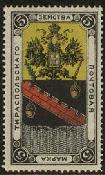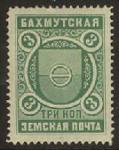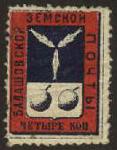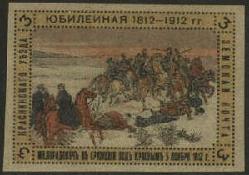|
RUSSIA ZEMSTVOS
(taken from the catalogue by F.G.
Cuchin)
THE RURAL (ZEMSTVO) POST.
According to the establishment of the Zemstvo in the middle of the
sixties the local administration and the local economical activity has
become centered in the districts. The District Zemstvo-Offices at the
head of the Zemstvo organization experienced the urgent need of postal
communication within the boundaries of the district. There were post-offices
of the State in town, and a very restricted numbers of them in the larger
villages; as to the rest, the inhabitants were obliged, in order to
deliver and to receive the mail to drive to a distance of 40-50 versts,
or more, especial in the north of Russia.
The Zemstvo-Offices were meant to supply to the local educational and
sanitary needs and to maintain the ways and means of communication;
the organization of a Zemstvo Post was the more necessary.
According to the Russian laws, the post was the monopoly of the State
and no other analogous organization was allowed. The Zemstvo Post, on
the contrary, was considered as carrying on the work of the State Post
in the localities where there was none, but not as competing with it,
and thus its organization and its activity was not interfered with.
The first Zemstvo-Post has been opened in the Vetluga district of the
government of Kostroma; at first, it had no stamps; it was in the Shlisselburg
district of the gov. of S.-Petersburg, where a Zemstvo post-office has
been opened in Sept. 1865, that they appeared for the first time.

Up to 1870 the Zemstvo-Post has not yet been formally legalized; still
at about that time these new post-offices with stamps of their own have
been opened in more than 20 districts. According to the decree of the
27 of Aug. 1870 the Zemstvo-Post has been, at last, legalized. The Zemstvo
was allowed to transmit the mail on receiving it from the State post-offices
within the boundaries of the district (but not from one town to another),
to organize further postal communication, and was bound to be responsible
for the same. This post was to have its own stamps, differing from those
of the State and the postmen were not to wear the emblem of the State-Post-the
post-horn-on their bags.
This new organization has proved to be so efficient, that,
according to the new Zemstvo laws issued on the 12 of June
1890, the organization and maintainment of the local post
has been entrusted to the Zemstvo. It is not easy to trace
the development of the Zemstvo Post, because the opening
and the closing of the offices lay entirely with the local
Zemstvo authorities; in some localities, the mail was carried
cost free. A philatelist has to consider the number of stamps
issued by the Zemstvo-Post during a certain period in connection
with total number of Zemstvos that issued them during the
same time.
The following data grouped by decades
|
|
Number of districts having their
own stamp.
|
Number of the principal varieties. of stamps issued
during that period |
|
1865- 1869
|
30
|
53
|
|
1870 - 1879
|
102
|
433
|
|
1880 - 1889
|
92
|
469
|
|
1890 - 1899
|
94
|
793
|
|
1900- 1909
|
70
|
33t
|
|
1910 - 1917
|
48
|
348
|
make manifest the fact, that the ordination of the Home Office of 1870
concerning the post and the New Zemstvo Law of 1890 have greatly simulated
the development of the Zemstvo-Post; later on since 1900 the issuing
of new Zemstvo-stamps seems to be firmly established.
According to the law of 1864 the Zemstvo has been organized in 36 governments,
containing 371 district; in 33 there was a Zemstvo-Post, too, but stamps
came into use in 162 districts only.
The dispatching of the mail being cost free in some localities, we
cannot judge about the development of the Zemstvo Post after
the data we have got concerning localities where stamps
were used. In 1892, for instance, the Zemstvo Post is known
to have been organized in 150 districts, but we have got
stamps of that period only for 89.
Want to see a map of the governments?,
then click here
To judge after the stamps in use, the Zemstvo Post organization must
have been fully developed only in two governments-those of Kherson and
of Pérm-and considerably, in Vologda, Viatka, Novgorod, Pskof;
districts with stamps of their own are known in the gov. of Voronezh,
Yekaterinoslaf, Kursk, Moskow, Poltawa, Riazan, Samara, St-Petersburg,
Satatof, Tambof, Twer, Toula, Kharkof, lt is characteristic, for instance,
that the gov. of Viatka with its peasant Zemstvo had a post organization
in all the districts (they were 11), but only in 7 stamps came into
use. During the year of 1888 more than 700000 postal packages have been
delivered through the Zemstvo post of Vlatka. How far, from reliable
it is to judge about the activity of the Zemstvo-Post after the occurrence
of stamps, the distance of the gov. of Simbirsk clearly shows: we have
got stamps of the year 1867 only for the Alatyir district, the post
being cost free in 5 districts out of eight.
In the localities where stamps were used their varieties
amount to 3.000. Among other post-free post cards (distr.
of Pskof), wrappers (distr. of Bogorodsk) and stamped enveloppes
were used (distr. of Bogorodsk, Bronitzy, Kadnikof, Kazan,
Luga, Okhansk, Ostrof, Ustsyssolsk, Rzhef, Soroki, Totma,
Tula, Volchansk; in Fatezh and Ttoropets starnped envelopes
alone).

II.
The Rural stamps were at first made at the local lithographing and
typographing offices, their size and their pattern is very
varied, sometimes, quite unknown in other branches of philatelia
They are often very big, so as to close a letter with envelopes
being scarce in remote rural localities; some have the shape
of a vertical or horizontal lozenge (Pskof, .Ostrof), some
are oval (Vessiegonsk), round (Kassimof) or square. They
were mostly made by lithographic method, less often manufactured
at printing offices. Sometimes they were made with the help
of a metallic land-jigger or printed on a hectograph. Stamps
made at the larger towns with the help of better technical
means are sometimes very fine specimens of graphic workmanship.
The Rural stamps had to be quite different from those of the State,
especially at the beginning, when the Melitopol district stamps even
confiscated on account of their too close similarity to those of the
State; later on, however, even such stamps (Mor shansk, Bugulma, Buguruslan)
were tolerated; in the districts of Twer and Borovichi they were even
made after the same pattern, differing only in color.
In some districts we observe a tendency towards new designs and the
imitation of foreign stamps; in that of Griazovets, for instance, there
were imitations of Swiss, Bavarian and Hungarian stamps. Some districts
haven chosen a certain design, kept it permanently the separate issues
differing from each other only in shades of color and in some details
(Podolsk, Kamyslilof etc).
The earlier stamps have no perforation; later on, it is very varied
sometimes even made with the sewing-machine. Very often some stamps
of the same issue have it, and some of them not. It happens, too, that
the stamps are perforated in one district only.
The local lithographers arranged some of the stamps horizontally for
the sake of economizing the paper, if here was no place for a vertical
arrangement; that is why we find some couché stamps among those
of the Zemstvo. It happens rather often, that in a row of stamps one
is turned upside down (téte-béche) either by mistake or
as the result of printing stamps in groups repeatedly on the same sheet;
this is a peculiar téte-béche type with a considerable
space between the stamps.
Besides these particular features there are different types to be discerned
among the Rural stamps. When a group of clichés was made, there
was a slight difference between the single stamps; when the cliché
was transferred to stone, there types alternated in a certain order.
These stamps, together with their disposition-on the sheet, are of great
importance for the discerning of the separate issues of stamps of the
same pattern.

Among the peculiarities quite unknown in other branches of philatelia,
the following must be pointed out:
stamps with counterfoils bearing the same number; they were torn off
and, did as quittances, certifying the delivery of the letter at the
post; they were registered and thus enabled to control the despatch
of the letter to the addressee (Zadonsk, Kotelnich),
- stamps with numbers written on them for the same purpose (Krapivna,
Lubny),
- stamps for paying the annual subscription to newspapers and journals
(Lubny).
The Zemstvo-Post being meant to transfer the mail from the State post
to remote localities, additory stamps very soon became necessary (Bogorodsk);
instead of issuing special stamps for that purpose, the usual ones in
some districts were marked so as to show that the postal package has
not been paid for.
Sometimes stamps not of different color only but of different value,
too, were printed on the same sheet (Griasovets, Biezhetsk, Rostof on
Don, Bobrof Pskow etc).
The paper they were printed on was far from being uniform; one can see
quite similar stamps printed on a different kind of paper. For discerning,
if this is due to chance, or to the stamps belonging to different issues,
it is necessary to consider other details the coloring, the space between
the stamps, the shape of the perforation, etc.
The Zemstvo-stamps issued by the State-Paper Printing Office first
appeared in 1884 and gradually came to prevail among others.
There were 5 principal types of them:
- Made for the post of the Ostrof district; artistic design. small
size (181/2x 241/2 mm), two - colored since 1885 and one-colored from
the nineties for economy's sake. In 1887 similar stamps for the Lebedin-district
appeared for the first time; they have been,two-colored up to 1916.
- Very soon a second type appeared, destined for the district of Arzanlas
and marked out its size (22 1/2x 283/4, mm.) and the method of printing.
The stamps were printed on a guilloché ground of the same color
as the design, which was taken from the stamps that have been formerly
manufactured and used in that district; the other Zemstvos have never
imitated it.
- This is the Bielozersk and Bakhmut type appeared first in 1883 in
the districts of Bielozersk and Yeletsk. Very soon the same design
was taken up in the districts of Sarapul (1893), Stavropol (1894)
Novouzensk (1897), Sumly (1898), Livny (1900) and Bakhmut (1901).
Since 1902 they were substituted by stamps of the so called Ardatof
type, but the former design came into use again, as the Zemstvo of
Shadrinsk ordered clichés for stamps in 1910. There are three
variaties of this type:
1) size 191/2x261/2, mm., one colored the general type of such stamps;
2) same size two-colored, the gnilloché ground and the design
being of two different colors (Novouzensk and Sumy);
stamps having an additory frame at the distance of 1 mm and, consequently,
a size of 22 x 29 mm. (some stamps of the Shadrinsk-district).
- Issued since 1901 exclusively for the Petrozavodsk-district, these
stamps are less numerous. They are one colored and rather like those
that in some towns are put by the police on passports.
A clear and artistic design is presented by the stamps of the Bielozersk
and Bakhmut type soon substituted by that of Ardatof. Their
sizes 191/2x261/2mm; they are always one-colored. First
issued in 1902 for the Ardatof district, they became a favourite
type at the State-Papers Printitig Office as a model for
stamps made for other districts to the very end of the Zemstvo
Post's existence. Such stamps were used in 30 districts.
In spite of their uniformity we can discern among them two
variaties beside the principal type:
- the brown stamp of 1913 with a pink guilloché ground, printed
for the district of Wessiegonsk;
- the general, type one colored with no hatching on the design in
the middle of the upper part of the stamp (Dankof, Zolotonosha, Krasnouflimsk,
Lgof and Chistopol).

The stamps issued by the State-Paper Printing office have the same
perforation (111/2, 121/2, and 1/213) but even then we can observe variaties
as to the size of the holes formed by perforation. Different spaces
between the stamps are to be seen in some issues otherwise uniform (Sarapul
district); this helps us to discern the single series.
A very restricted number of stamps issued by the State-Paper Printing
Office has no perforation at all. If there is a vertical perf., a horizontal
one is never missing, either and vice-versa.
At the period of ordering stamps at the State-Paper Printing Office
the Zemstvos sometimes had practically none left for use; the local
manufacturing of stamps by lithographic method had to supply to that
need. These stamps differed greatly from their model. A rare exception
are the stamps of the Chistopol district that would scarcely differ
at all from those issued by the Printing Office, if it were not for
a differ perforation and wider margins.
As to the methods of canceling stamps at the post it was formerly usual
to mark them with ink and to denote the date; later on special stamping
came into use, but at the same time the former methods were used, too.
It ought to be pointed out that amateurs very often come across stamps
not mentioned in any catalogue; they are either reprints differing from
the original in coloring or proofs. As to the forged stamps they have
sometimes quite a phantastic design unknown to any Zemstvo.
III
The Russian Rural stamps have been more taken notice of abroad than
in Russia itself. The first work on them was published in 1875 in Bruxelles
by the firm of .J.B. Moens. It was a catalogue of J. Koprovsky: .Les
timbres post ruraux de Russia. Later on, the editors have included the
Zemstvo-stamps into their general catalogue of Russian stamps, which
has been published repeatedly during the nineties.
The Russian Rural-stamps have been published with special care in English
catalogues. In The stamps collector's handbook by Edward L. Pembetton
(1878) there are 50 pages of them, but the prices are not mentioned;
this is omitted in Dr John Edward Gray's .Illustrated catalogue of postage
stamps', too. Of all the works on Russian stamps in English the most
prominent is W. Herrick's- Catalogue of the Russian rural stamps' published
in 1896 by The Scott Stamp and Coin Co Ltd, New-York. A special local
post catalogue, dealing largely with Russian stamps has been published
up to 1899 in London by the firm of Stanley Gibbons. The German philatelistic
literature has also taken a considerable interest in Zemstvo-stamps,
especially in catalogues. In the eighties Lübkert's well known
work was published; in 1895 P. Treskow's Katalog der russischen Zemstwo
Postwertzeichen in the Austria Philatelist'; this catalogue does not
go farther than the stamps of Bogorodsk of 1891. In 1912 the firm Philipp
Kosack in Berlin has published a Preiskatalog der Postwertzeichen der
Russischen Landschaftsämter'.
As to the russian works, the book of D. Chiudnofsky has been completed
and published in Kief in 1888 (.The description of Russian Zemstvo-stamps,
envelopes and wrappers'). This book is not illustrated at all and does
not mention the prices; therefore, it is scarcely adapted for practical
use.
In 1914 P.P. Ganko has published a brochure on the Zemstvo Post of the
Poltava district, where an amateur will find a great deal of material
for his work.
In 1910- 16 the Catalogue of Russia Rural Stamps' by C.C. Schmidt was
published by numbers, but remained incomplete; it reaches up to the
letter K.
The collectioneering of Zemstvo-stamps in Russia has not been developed
as it ought to be according to the interest that those stamps afford;
it has been the pursuit of a restricted number of amateurs.
The Dresden Philatelist Society had in St. Petersburg a
section,which was the chief centre of collectioneering Zemstvo-stamps.
This section was founded at about 1881; F.L. Breitfuss soon
became the head of it. He had a very large correspondence
with the Zemstvo Offices. It was not easy work in Russia
in those times; very often the Zemstvos would refuse to
forward stamps (that of Alatyir, for instance) under the
plea of the stamp being destilled exclusively for the use
of the local post. Breitfuss's correspondence has been handed
over to the society and presents a great deal of material
for further work. G.R. Kirchner, the vice president of the
Petersburg section, and E.S. Lenz, the secretary, have been
studying Zemstvo stamps and Lenz had them sent from the
Zemstvo-Offices in order to distribute them among the members
of the society. At that period C. C. Schmidt and A. C. Fabergé,
members of the society began to study these stamps, too.
After the death of Breitfuss and the retirement of Leuz
Schmidt was elected President, and L.L. Breitluss-Secretary
of the society. Breitfuss carried on Lenz's work in supplying
the members with stamps, forwarded directly from the Zemstvo
Offices. About this time the section of the Dresden Society
was reformed and reorganized as the Russian Philatelist
Society of St. Petersburg.
Another centre of the same studies was in Moscow. Among the members
of the Philatelist society there E. von der Beeck, A. G. Go'dstege,
Sievert, Hornung and Albert Steldel must be mentioned.
The materies that they have collected enabled Schmidt and Fabergé
to begin their work Die Postwertzeichen der Russischen Landshaftsáters
which began to be published by numbers in 1908 with illustrations in
separate pages. This is classical and complete study of the large material
that was at hand. Up to 1916 20 issues appeared, forming two large sized
volumes of about 900 pages with 102 phototypical tables. This work was
stopped at the letter L. later on, it has altogether ceased to appear
and the remains of this edition have mostly gone astray. The collectioneering
of Zemstvo-stamps was therefore again lacing a difficult position. It
was necessary to collect the rest of the material into a guide book
for amateurs; this work was commenced in 1918 by a section of Leningrad
philatelist (S. S. Antonof, L. L. Breitfuss, A. C. Fabergé, A.
A. Khalfan, A. A. Kraus, K.K. Melikof) with the purpose of producing
a simple and popular guide-book, so as to help to discern the various
types of stamps. Several difficulties chiefly of financial character
arose during the work and only now in 1925 it is being published under
the leadership of F.G. Cuchin Commissioner of the State Philatelist
Organization.
S. Antonof.
Alphabetic index of the governments:
|
Bessarabia
- Orgheef
- Soroki
- Yassi
|
Novgorod
- Bielozersk
- Borovichy
- Cherepovets
- Demiansk
- Kirillof
- Novgoroa
- Staraya-Russa
- Tikhvin
- Ustiuzhna
- Valdai
|
St.-Petersburg
- Gdof
- Luga
- Novaya Ladoga
- Shlisselburg
|
Ufa
- Belebey
|
|
Chernigof
- Kozelets
- Oster
|
Olonets
- Petrozavodsk
- Pudozh
|
Saratof
- Atkarsk
- Balashof
- Khvalynsk
- Kuznetsk
- Saratof
- Volsk
|
Viatka
- Glazof
- Kotelnich
- Malmyzh
- Nolinsk
- Sarapul
- Urzhum
- Viatka
|
|
Kharkof
- Akhtyirka
- Kharkof
- Lebedian
- Starobyelsk
- Summy
- Valki
- Volchansk
|
Orel
- Livny
- Maloarkhangelsk
- Yelets
|
Simbirsk
- Aletyir
- Syzran
|
Vladimir
- Pereslaf
|
|
Kazan
- Christopol
- Kazan
- Lahishef
- Tetyushy
|
Penza
- Chembary
- Penza
- Saransk
|
Smolensk
- Dukhovstchina
- Krasny
- Smolensk
|
Vologda
- Griazovets
- Kadnikof
- Nicolsk
- Totma
- Ustsysolsk
- Veliki Ustyug
- Velsk
- Yarensk
|
|
Kherson
- Alexandria
- Ananief
- Kherson
- Odessa
- Tiraspol
- Yelisavetgrad
|
Perm
- Cherdyn
- Irbit
- Kamyishlof
- Krasnoufimsk
- Kungur
- Osa
- Okhansk
- Perm
- Shadrinsk
- Solikamsk
- Verkhotur
- Yekaterinburg
|
Tambof
- Borisoglyebsk
- Lebedian
- Morshansk
- Shatsk
- Tambof
|
Voronezh
- Bobrof
- Boghuchary
- Ostrogozhsk
- Zadonsk
- Zemliansk
|
|
Kostroma
- Kologrif
- Vetluga
|
Poltava
- Gadiach
- Kobelaky
- Konstantinograd
- Kremenchug
- Lokhvitza
- Lubny
- Peryaslaf
- Piriatin
- Poltava
- Priluky
- Zienkof
- Zolotonosha
|
Tavrik
- Berdyansk
- Dnieprovsk
- Melitopol
|
Yekaterinoslaf
- Bakhmut
- Mariupol
- Novomoskofsk
- Pavlograd
- Verkhnednieprovsk
- Yekaterinoslaf
|
|
Kursk
- Dmitrief
- Lgof
- Schigry
- Sudzha
|
Pskof
- Kholm
- Novorzhef
- Opochka
- Ostrof
- Porkhof
- Pskof
|
Territory of the Don
- Cherkassy
- Donez
- Rostof
|
|
|
Moscow
- Bogorodsk
- Bronnitzy
- Dmitrof
- Kolomna
- Podolsk
|
Ryazan
- Dankof
- Kassimof
- Ryazhsk
- Ryazan
- Sapozhok
- Skopin
- Spassk
- Yegoryevsk
|
Twer
- Byezhetsk
- Korcheva
- Ostashkof
- Rzhef
- Twer
- Vessiegonsk
|
|
|
Nizhni-ovgorod
- Ardatof
- Arzamas
- Vasil
|
Samara
- Bugulma
- Buguruslan
- Buzuluk
- Novousensk
- Samara
- Stavropol
|
Tula
- Chern
- Kashira
- Krapivna
- Tula
|
|
|



